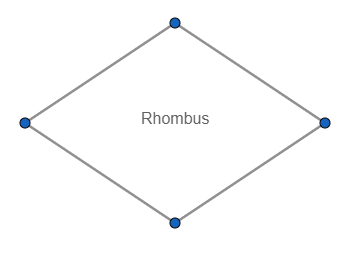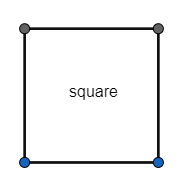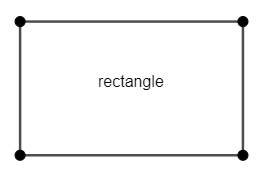
A quadrilateral with four equal sides and no right angles can be called a _______.
Answer
504.9k+ views
Hint: It is given that all four sides of a quadrilateral are equal. So, the first thing we can make out from here is that it is for sure a parallelogram as each pair of opposite sides are equal. The other thing we can conclude is that it is either a square or a rhombus, as the parallelograms with all sides are equal can either be a rhombus or a square. Also, use the point that the quadrilateral has no right angles to reach the answer.
Complete step by step solution:
Let us try to remember the definitions of all the figures mentioned one by one. First let us start with Rhombus. So, rhombus is a parallelogram with all its sides equal and diagonals perpendicular to each other.

Now, a rectangle is a parallelogram with each of the interior angles measuring


Now let us move to the actual solution to the above question. It is given that all four sides of a quadrilateral are equal. So, the first thing we can make out from here is that it is for sure a parallelogram as each pair of opposite sides are equal. Also, from the above definitions we know that the parallelogram with all sides equal is either a rhombus or a square. But it is mentioned that none of the angles of the quadrilateral is a right angle, so we can say that it is not a square.
Therefore, we can conclude that a quadrilateral with four equal sides and no right angles can be called a rhombus.
Note: It is important to remember the properties of the mentioned standard quadrilaterals, as they are used very often. Also, be very clear about the definitions and don’t mix up their properties because they sound very similar and confusing. Also, make sure that you are using all the data and properties mentioned in a question to reach the final answer in such questions.
Complete step by step solution:
Let us try to remember the definitions of all the figures mentioned one by one. First let us start with Rhombus. So, rhombus is a parallelogram with all its sides equal and diagonals perpendicular to each other.

Now, a rectangle is a parallelogram with each of the interior angles measuring


Now let us move to the actual solution to the above question. It is given that all four sides of a quadrilateral are equal. So, the first thing we can make out from here is that it is for sure a parallelogram as each pair of opposite sides are equal. Also, from the above definitions we know that the parallelogram with all sides equal is either a rhombus or a square. But it is mentioned that none of the angles of the quadrilateral is a right angle, so we can say that it is not a square.
Therefore, we can conclude that a quadrilateral with four equal sides and no right angles can be called a rhombus.
Note: It is important to remember the properties of the mentioned standard quadrilaterals, as they are used very often. Also, be very clear about the definitions and don’t mix up their properties because they sound very similar and confusing. Also, make sure that you are using all the data and properties mentioned in a question to reach the final answer in such questions.
Recently Updated Pages
Master Class 9 General Knowledge: Engaging Questions & Answers for Success

Master Class 9 English: Engaging Questions & Answers for Success

Master Class 9 Science: Engaging Questions & Answers for Success

Master Class 9 Social Science: Engaging Questions & Answers for Success

Master Class 9 Maths: Engaging Questions & Answers for Success

Class 9 Question and Answer - Your Ultimate Solutions Guide

Trending doubts
Fill the blanks with the suitable prepositions 1 The class 9 english CBSE

Difference Between Plant Cell and Animal Cell

Given that HCF 306 657 9 find the LCM 306 657 class 9 maths CBSE

The highest mountain peak in India is A Kanchenjunga class 9 social science CBSE

What is the difference between Atleast and Atmost in class 9 maths CBSE

What is pollution? How many types of pollution? Define it




